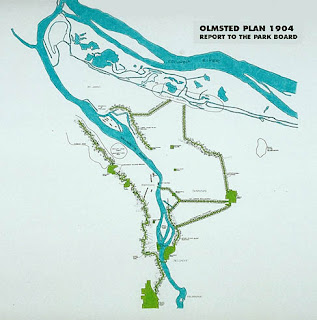Biking and walking are the most ecological forms of transportation, and reducing automobile dependency is key to the Portland initiative. The tipping point occurred in 1996 when a new freeway project, the "Western Bypass," was killed. LUTRAQ, a definitive study assessing the interconnection of Land Use, Transportation, and Air Quality, determined that investing in transportation options would secure a better return of public funds. http://www.friends.org/resources/reports Replacing a drivable suburban standard with a walkable urbanism pattern centered on light rail also achieved the goal METRO, Portland's Regional Government, set in its 2040 plan. Building on this foundation, the new Climate Action Plan expects to reduce Vehicle Miles Traveled by 30 percent from 2008 levels by creating "Complete Neighborhoods," where "residents can walk or bike to meet all basic daily non-work needs and have safe bicycle or walking access to transit."
 |
| Portland's regional rail corridors and walkable urbanism sites |
Creative Village occupies a prominent 60 acre infill site on the edge of downtown, and building an urban campus for nation's third largest university (its 60,000 students attend a sprawling suburban campus) could ignite Central Florida's tech industry and revitalize Parramore, the adjacent historic African-American neighborhood. UCF's energy and expertise was set to activate plans to improve the health: physical, social, and economic, of a historically underprivileged population. http://www.cityoforlando.net/city-planning/plans-and-studies/parramore-comprehensive-neighborhood-plan/ In a state burdened by a history of racial injustice, this project offered an essential prototype to offer, as one city council member put it, "a hand up and not a hand out."
Scott's actions are part of a depressing pattern. He rejected federal dollars for the Affordable Care Act and high speed rail, delayed the construction of SunRail, emasculated the state's water management districts, and hijacked Amendment 1 http://www.1000friendsofflorida.org/amendment-1-funds-allocated/ Rick Scott is directing the systematic failure of Florida's urban and natural systems. He is the anti-Christ to Pope Francis's encyclical calling Christians to "Care for our Common Home."
 |
| Sermons and Deeds of the Anti-Christ |
Signorelli's message is timeless. A pile of riches lay at the feet of the Anti-Christ, who obviously had a successful fund raising campaign. Notice the demonic figure is sharing information, perhaps the secret to leech more wealth from his audience. Rick Scott spent millions of his own money to get elected, perhaps that is the saving grace. Who would listen to him?
To read more on racal injustice and city planning in Florida, consult my article in the forthcoming issue of VIEW http://lalh.org/magazine/













